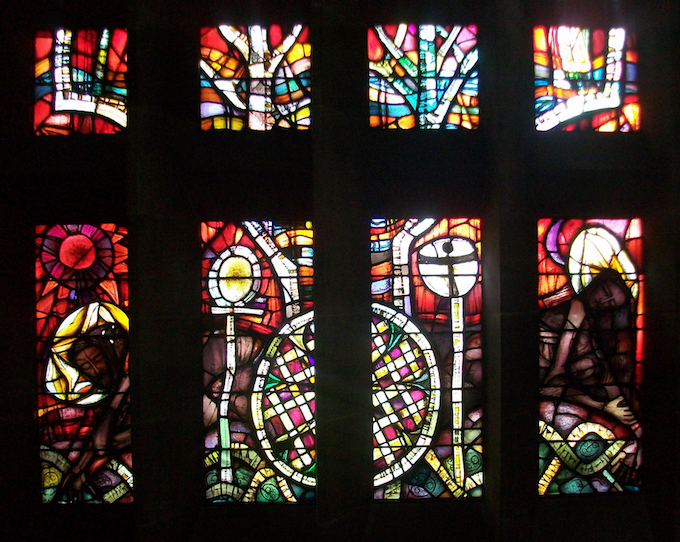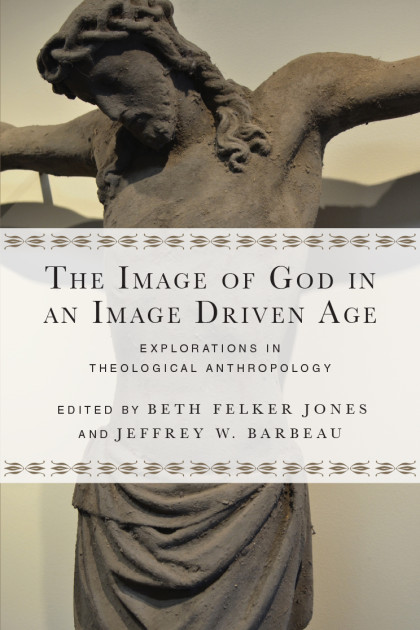 Michael Huerter continues his series responding to The Image of God in an Image Driven Age: Explorations in Theological Anthropology, edited by Beth Felker Jones and Jeffrey W. Barbeau (Downers Grove, IL: InterVarsity Press, 2016). See Part 1 of Michael’s explorations here. Image: Coventry Cathedral – Man and Woman, Adam and Eve, from Art in the Christian Tradition, a project of the Vanderbilt Divinity Library, Nashville, TN. http://diglib.library.vanderbilt.edu/act-imagelink.pl?RC=54890 [retrieved October 30, 2016]. Original source: http://www.flickr.com/photos/clairgraubner/4411532983/.
Michael Huerter continues his series responding to The Image of God in an Image Driven Age: Explorations in Theological Anthropology, edited by Beth Felker Jones and Jeffrey W. Barbeau (Downers Grove, IL: InterVarsity Press, 2016). See Part 1 of Michael’s explorations here. Image: Coventry Cathedral – Man and Woman, Adam and Eve, from Art in the Christian Tradition, a project of the Vanderbilt Divinity Library, Nashville, TN. http://diglib.library.vanderbilt.edu/act-imagelink.pl?RC=54890 [retrieved October 30, 2016]. Original source: http://www.flickr.com/photos/clairgraubner/4411532983/.
Genesis 1:26-28:
Then God said, “Let us make humankind in our image, according to our likeness; and let them have dominion over the fish of the sea, and over the birds of the air, and over the cattle, and over all the wild animals of the earth, and over every creeping thing that creeps upon the earth.”
So God created humankind in his image,
in the image of God he created them;
male and female he created them.God blessed them, and God said to them, “Be fruitful and multiply, and fill the earth and subdue it; and have dominion over the fish of the sea and over the birds of the air and over every living thing that moves upon the earth.”
The image of God is a primary characteristic of humanity from the first chapter of the Bible. It is spoken by God and holds a central place in the Judeo-Christian Creation narrative, and has consequently been debated through the centuries. Current discussions about the image of God, what precisely it means that God created humans in God’s image, are not unanimously decided, but rather evidence a variety of perspectives. The Image of God in an Image Driven Age presents three significant ways of describing the image of God. The first of these proposes that the image of God is something substantial about humans, some characteristic that sets humans apart from other creatures (e.g. rationality, self-awareness, the ability to conceive of transcendence or the divine). The second suggests that the image of God denotes something functional about humanity—that human beings bear God’s image by functioning as representatives of the Creator King to creation. The third connects the image of God to humanity’s relational potential, claiming that it is in relationships with God and with one another that human beings bear the divine image.
In systematic theology, the dominant tendency is often to attempt a narrowing of view, a selection of the best possible answer. Theology is sometimes conceived of as a puzzle to solve, so that if we construct an equation of enough passages of Scripture we will find a simple, “correct” answer at the other end. I think The Image of God in an Image Driven Age presents us with another way. Each author in this book has contributed an essay to an eclectic collection; each perspective offered provides unique insight. To apply a systematic method to such a resource would suggest that one of twelve essays must be true by falsifying the others, or else that the proper way forward would be to combine the dozen perspectives present in the book and construct one that as nearly as possible approximates their sum.
But what if bearing the image of God is not about having the perfect answer to what the imago Dei is? What if, instead of narrowing our view to achieve precise theology, we broadened the scope of our thought and conversation, in the hope of attaining lived theology? That is what I think this book does: it invites scholars from every field to bring their life experience, their expertise, and their passions to bear on this question. It asks them to share what they have seen of God in humanity; it asks them to share how they have seen the true and good nature of humanity corrupted or devalued; it asks them to imagine and live toward a world in which we treasure and honor the divine blessing given to each person.

If this blog series achieves one thing, I hope it succeeds in extending an invitation to you. Receive this as an invitation to join in the conversation. Whatever dreams and passions you are pursuing, whatever injustices you hope to right, whatever knowledge you seek to master, do it as an image-bearer. Let’s find new ways to understand and live out the imago Dei. Because you bear the image of God, you have a unique opportunity to reveal that image. We will continue to explore what that means, but this is a theology of journeying, of diversity, and of faithful living, not just books and intellectual precision. The image of God is not something that you must first understand and then finally achieve: it is woven into the way you have been created by God.
Think of the responsibility or relationship that you will next encounter—a project, a meeting, a conversation. What might it mean in that circumstance that you are made in the image of God? What might it mean that the other people you will interact with also bear that image? How will you act differently because of that?
Michael Huerter is a graduate of Messiah College, and is currently pursuing a Master of Divinity and a Master of Music in Church Music at Truett Seminary and Baylor University in Waco, Texas. He is passionate about making music, and particularly enjoys jazz. He also enjoys being an uncle to his two nieces and one nephew, and a “dad†to his 110-lb Shiloh Shepherd, Tinkerbell. His academic interests include worship theology and the intersection of faith, culture, and storytelling, and an item on his bucket list is to compose music for a soundtrack.

Leave a Reply